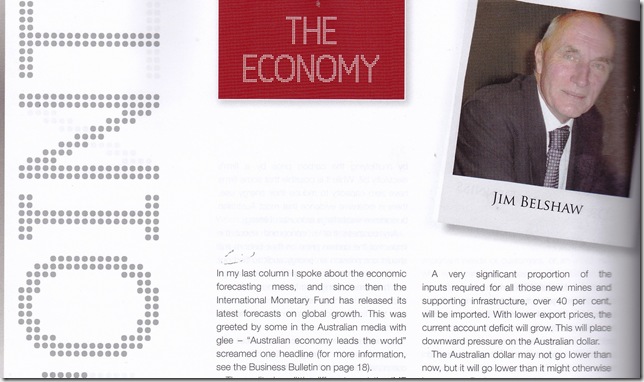Note to readers: This column appeared in the June/July edition of Australian Business Solutions magazine. It was written just before the budget. It's not on-line, so I have re-published it here.
In my last column I spoke of the economic forecasting mess. Since then, the International Monetary Fund has released its latest forecasts on global growth. This was greeted by some in the Australian media with glee - “Australian economy leads the world” screamed one headline.
The reality is a little different, for the IMF is actually a good example of what I have been taking about. In recent years, its forecasts have been all over the place like a dog’s breakfast! So what did the IMF actually say? Well, not quite what the headline would suggest.
To begin with, the IMF suggested that there was some strengthening in the global economy, although this was heavily qualified in some ways with recognition of the various risk factors. But what did the IMF think of Australia? The IMF actually projected some further weakening in the Australian economy. We are still forecast to do relatively well by the standards of other developed nations, but hardly well enough to suggest that the Australian economy leads the world!
But in all this confusion what can we actually say about the Australian economy? The first and most important point is that world commodity prices will continue to weaken, reducing returns on our major exports. Why do I say this? It’s simple. The structural imbalances that developed in the global economy over the long boom are still there. They will take time to unwind. So long as they continue, global economic growth will continue to be weak. In turn, this means weakened demand for commodities.
Yet despite the fall in commodity prices, the Australian mining investment boom will continue, if at a lower level than previously forecast. Work already under way guarantees that. This means, in turn, that pressures on the non-resource sectors will continue. However, it’s not all doom and gloom.
A very significant proportion of the inputs required for all those new mines and supporting infrastructure, over 40 per cent, will be imported. With lower export prices, the current account deficit will grow. This will place downward pressure on the Australian dollar.
The Australian dollar may not go lower than now, but it will go lower might otherwise have been the case. Both export and import competing industries will be better off as a consequence. There will be more time to adjust.
But the story doesn’t end here. World growth may be slow, but it is still positive. This means that the total marketplace for Australia’s non-resource exports will grow. Importantly, the fastest growing marketplaces will continue to be in our immediate region, which gives us an advantage. The decline in commodity prices will also increase the relative return on non-mining investments, encouraging investment outside mining.
Taken together, we are likely to see a smaller resource sector than would otherwise have been the case, a larger non-resource sector.
For the present, the Australian economy should continue to grow if below the trend rate - and the biggest immediate economic risk? It’s actually the budget!
By the time you read this, we will know what Treasurer Swan has in mind. Looking at the numbers, the size of the apparent spending cuts required to return the budget to surplus will place considerable downward pressure on economic activity. That pressure will be felt most by the non-resource sectors of the economy, just those sectors adversely affected by the mining boom. That would be a pity.

